![]() The first design for HLCU electronic block has been started in Remote Sensing Department in 1999.
The preliminary phase of HIFI development was finished in 2000. The requirements for instrument and its description were published in the following documents: Instrument Requirement Review and Preliminary Design Review.
The first design for HLCU electronic block has been started in Remote Sensing Department in 1999.
The preliminary phase of HIFI development was finished in 2000. The requirements for instrument and its description were published in the following documents: Instrument Requirement Review and Preliminary Design Review.
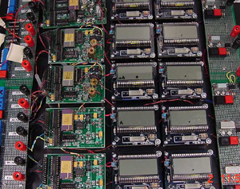
![]() In the middle of 2001 the first laboratory prototype of LO Control Unit was manufactured in SRC and then tested in JPL in Pasadena.
In the middle of 2001 the first laboratory prototype of LO Control Unit was manufactured in SRC and then tested in JPL in Pasadena.
![]() In September 2001 the HIFI Management Meeting was held in Warsaw.
In September 2001 the HIFI Management Meeting was held in Warsaw.
![]() Basing on the results of the tests in JPL, the fully working HLCU AS engineering model called Advanced Simulator was finished and tested in Warsaw.
In February 2002 it has been delivered to Local Oscillator team in Max Planck Institute for Radioastronomy in Bonn.
Basing on the results of the tests in JPL, the fully working HLCU AS engineering model called Advanced Simulator was finished and tested in Warsaw.
In February 2002 it has been delivered to Local Oscillator team in Max Planck Institute for Radioastronomy in Bonn.
![]() The first integration of HLCU AS with HIFI Instrument Control Unit and the other subsystems was successfully done in SRON in Utrecht in May 2002.
The first integration of HLCU AS with HIFI Instrument Control Unit and the other subsystems was successfully done in SRON in Utrecht in May 2002.
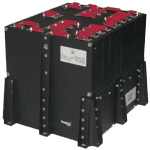
![]() The Avionic Model of HLCU AVI has been connected to LO system in December 2002.
The Avionic Model of HLCU AVI has been connected to LO system in December 2002.
![]() In February and in May 2003 two LCU simulators controlled from PC via serial RS interface were delivered to Jet Propulsion Laboratory
in Pasadena. They have been used there during tests of the microwave bands developed in JPL.
In February and in May 2003 two LCU simulators controlled from PC via serial RS interface were delivered to Jet Propulsion Laboratory
in Pasadena. They have been used there during tests of the microwave bands developed in JPL.
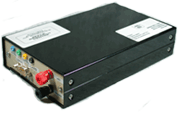
![]() The successful integration of the HLCU IMD with the whole HIFI system was done in July 2003 in SRON Groningen.
The successful integration of the HLCU IMD with the whole HIFI system was done in July 2003 in SRON Groningen.
![]() The Development/Qualification Model of HLCU has been delivered to LO team in Bonn in December 2003.
The Development/Qualification Model of HLCU has been delivered to LO team in Bonn in December 2003.
![]() In April 2004 the thermo-vacuum tests of LCU QM have been performed in Utrecht.
In April 2004 the thermo-vacuum tests of LCU QM have been performed in Utrecht.
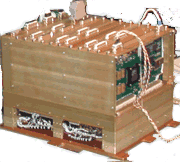
![]() In June 2004 two blocks: HLCU/HLSU Interface Board DM and HLCU Simulator were delivered to COMDEV in Cambridge, Ontario. They were made in SRC:
the former will be implemented to HLSU DM, the latter will be used in COMDEV for HLSU controlling from the PC level. The full tests of both blocks were done and the future modifications have been discussed to ensure the FM unit be in accordance to ESA and NASA certificates as well.
In June 2004 two blocks: HLCU/HLSU Interface Board DM and HLCU Simulator were delivered to COMDEV in Cambridge, Ontario. They were made in SRC:
the former will be implemented to HLSU DM, the latter will be used in COMDEV for HLSU controlling from the PC level. The full tests of both blocks were done and the future modifications have been discussed to ensure the FM unit be in accordance to ESA and NASA certificates as well.
![]() The second intermediate model HLCU-IMD2 was delivered to Bonn in 2005 . This block is used in MPIfR for frequency multiplier's calibration in LO system and for testing of new LO software.
In the new instrument the IV curve procedure was changed to enable get the more precisely measurements.
The second intermediate model HLCU-IMD2 was delivered to Bonn in 2005 . This block is used in MPIfR for frequency multiplier's calibration in LO system and for testing of new LO software.
In the new instrument the IV curve procedure was changed to enable get the more precisely measurements.
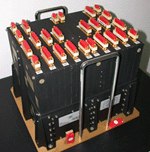
![]() In August 2006 EPROM version of flight HLCU-FM model was delivered to MPIfR in Bonn and it has been accepted during the incoming tests. Then the unit has been shipped to SRON Groningen. The integration at HIFI FM warm electronics level (PDU Main and Redundant, FHICU Main) has been succesfully finished.
Formal acceptance tests will be done after PROMs burning and implementation them to the board. Since September the Flight Model of HLCU has been under integration testing with all LO system in SRON Groningen.
In August 2006 EPROM version of flight HLCU-FM model was delivered to MPIfR in Bonn and it has been accepted during the incoming tests. Then the unit has been shipped to SRON Groningen. The integration at HIFI FM warm electronics level (PDU Main and Redundant, FHICU Main) has been succesfully finished.
Formal acceptance tests will be done after PROMs burning and implementation them to the board. Since September the Flight Model of HLCU has been under integration testing with all LO system in SRON Groningen.
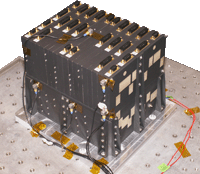
![]() In March 2007 PROMs containing the flight software were installed to microcontroller board and some modification in multiplexor board were done inside LCU in SRON Utrecht. After covering the "conformal coating" to modified boards, the whole flight unit of LCU was assembled and all screws were locked. After functional tests
LCU-FM unit with test setup equipment and cables was installed in EMC laboratory in NLR - Merknesse, where EMC tests were done. The conducted emission and conducted susceptibility were measured during the tests. Also vibration tests were done in NLR. The second phase of LO system and HIFI integration was performed in SRON Groningen (ILT-2) till the end of June.
In March 2007 PROMs containing the flight software were installed to microcontroller board and some modification in multiplexor board were done inside LCU in SRON Utrecht. After covering the "conformal coating" to modified boards, the whole flight unit of LCU was assembled and all screws were locked. After functional tests
LCU-FM unit with test setup equipment and cables was installed in EMC laboratory in NLR - Merknesse, where EMC tests were done. The conducted emission and conducted susceptibility were measured during the tests. Also vibration tests were done in NLR. The second phase of LO system and HIFI integration was performed in SRON Groningen (ILT-2) till the end of June.
![]() After the test in Groningen, HLCU-FM block with all HIFI instrument was shipped in the begining of July 2007 to Astrium - Friedrichshafen in Germany for the assembly, integration and test. The tests in Astrium lasted till December 2007.
After the test in Groningen, HLCU-FM block with all HIFI instrument was shipped in the begining of July 2007 to Astrium - Friedrichshafen in Germany for the assembly, integration and test. The tests in Astrium lasted till December 2007.
![]() In the begining of January 2008 all HIFI instruments have been transported to ESTEC for the integration tests on the spacecraft.
In the begining of January 2008 all HIFI instruments have been transported to ESTEC for the integration tests on the spacecraft.
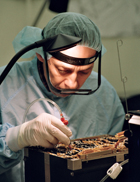
![]() In March 2008 the functional testing of the spacecraft and its payload was performed during SVT-1 (System Validation Test). The purpose of SVT-1 was to test and validate the external interfaces from the Missions Operations Centre (MOC, in ESOC) to the satellite (in ESTEC), in closed loop, and to validate the satellite telemetry and telecommand database definition, making use of satellite nominal and contingency flight operations procedures.
In March 2008 the functional testing of the spacecraft and its payload was performed during SVT-1 (System Validation Test). The purpose of SVT-1 was to test and validate the external interfaces from the Missions Operations Centre (MOC, in ESOC) to the satellite (in ESTEC), in closed loop, and to validate the satellite telemetry and telecommand database definition, making use of satellite nominal and contingency flight operations procedures.
![]() In April the Herschel telescope and solar arrays were mechanically integrated onto the interface structure on the satellite. The various tests were performed with the whole spacecraft: EMC (May), acoustic test (June) and vibration (July).
In April the Herschel telescope and solar arrays were mechanically integrated onto the interface structure on the satellite. The various tests were performed with the whole spacecraft: EMC (May), acoustic test (June) and vibration (July).
![]() The first System Operational Validation Test (SOVT-1) was executed in September 2008. For the first time, the whole Science Ground Segment (SGS) has been connected together and operating with the Mission Operations Centre (MOC) and the spacecraft in a complete end-to-end test simulating four days of routine science operations.
The first System Operational Validation Test (SOVT-1) was executed in September 2008. For the first time, the whole Science Ground Segment (SGS) has been connected together and operating with the Mission Operations Centre (MOC) and the spacecraft in a complete end-to-end test simulating four days of routine science operations.
![]() In October the Herschel spacecraft was hoisted into the Large Space Simulator (LSS). The LSS is the large vacuum chamber where the final major Herschel test campaign was conducted until December. Then for the first time, the HIFI local oscillator system was extensively tested end-to-end.
In October the Herschel spacecraft was hoisted into the Large Space Simulator (LSS). The LSS is the large vacuum chamber where the final major Herschel test campaign was conducted until December. Then for the first time, the HIFI local oscillator system was extensively tested end-to-end.
![]() After final testing in cleanroom conditions in LSS during January 2009, Herschel was shipped (by air!) to Kourou for the launch campaign in February 2009.
After final testing in cleanroom conditions in LSS during January 2009, Herschel was shipped (by air!) to Kourou for the launch campaign in February 2009.
![]() HERSCHEL was launched on 14 May 2009 at 15:12 (CEST) by Ariane rocket. After a perfect injection, the critical Launch and Early Orbit Phase (LEOP) started to wind down, while commissioning of the scientific instruments and subsystems on both spacecraft began.
HERSCHEL was launched on 14 May 2009 at 15:12 (CEST) by Ariane rocket. After a perfect injection, the critical Launch and Early Orbit Phase (LEOP) started to wind down, while commissioning of the scientific instruments and subsystems on both spacecraft began.
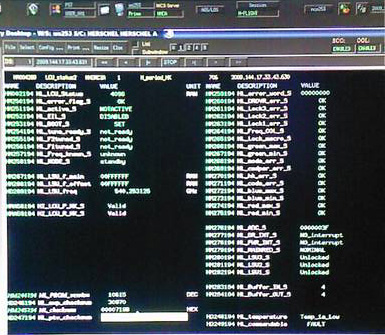
![]() On 24 May close to 17:00 UT the HIFI Local Oscillator Control Unit has been switched on for the first time in space and we are able to communicate with LO subsystem. The main heater has been programmed and after getting into operational temperature range in the following two days, the LSU and LOU have been switched on for the functional tests. All 14 LO channels are alive and show power levels at the detectors (mixers) consistent with previous on-ground measurements. No icing of the LO windows is apparent, as was considered a possibility from outgassing during launch, and no misalignment of the LO chains is apparent to within 1-2%. The HIFI instrument was fully functional and has started to be setup to work optimally for science operations.
On 24 May close to 17:00 UT the HIFI Local Oscillator Control Unit has been switched on for the first time in space and we are able to communicate with LO subsystem. The main heater has been programmed and after getting into operational temperature range in the following two days, the LSU and LOU have been switched on for the functional tests. All 14 LO channels are alive and show power levels at the detectors (mixers) consistent with previous on-ground measurements. No icing of the LO windows is apparent, as was considered a possibility from outgassing during launch, and no misalignment of the LO chains is apparent to within 1-2%. The HIFI instrument was fully functional and has started to be setup to work optimally for science operations.
![]() LCU unit (Main) worked up to 3 August, when the failure occured because of SEU effect. A lot of hard work was put during next months in trying to understand what really happened in HIFI. Numerous tests were performed in Warsaw with the digital boards of LCU spare model and in parallel in SRON Groningen with LCU-IM3 unit and other HIFI subsystems or simulators. Based on all the analysis and laboratory tests - initially only HIFI internal, later on supported by the ESA - the recovery action was designed and implemented to limit/prevent the failure in the redundant side. Some software changes and modifications were added into the new patch. The changes are mainly to minimize the possible unwanted effects caused by SEU and hardware procedure including a switch of the standby relay. In December the first formal step towards switching on HIFI was taken during HIFI review board and then the go-ahead was given by ESA.
LCU unit (Main) worked up to 3 August, when the failure occured because of SEU effect. A lot of hard work was put during next months in trying to understand what really happened in HIFI. Numerous tests were performed in Warsaw with the digital boards of LCU spare model and in parallel in SRON Groningen with LCU-IM3 unit and other HIFI subsystems or simulators. Based on all the analysis and laboratory tests - initially only HIFI internal, later on supported by the ESA - the recovery action was designed and implemented to limit/prevent the failure in the redundant side. Some software changes and modifications were added into the new patch. The changes are mainly to minimize the possible unwanted effects caused by SEU and hardware procedure including a switch of the standby relay. In December the first formal step towards switching on HIFI was taken during HIFI review board and then the go-ahead was given by ESA.
![]() In January 2010 all subsystems were switched on again (including Redundant LCU unit), new patch was uploaded to LCU memory and the HIFI has been back with its full capability.
In January 2010 all subsystems were switched on again (including Redundant LCU unit), new patch was uploaded to LCU memory and the HIFI has been back with its full capability.